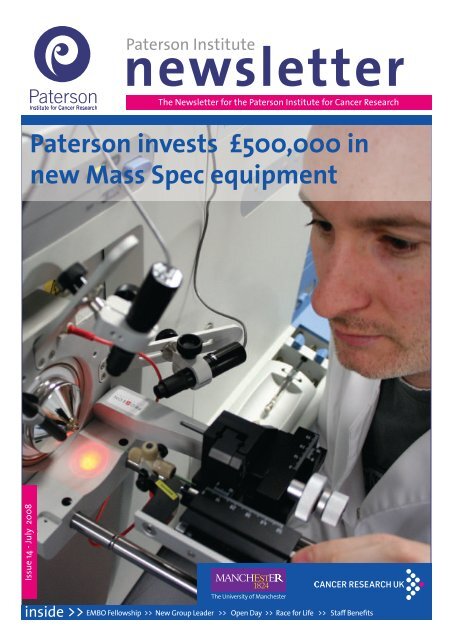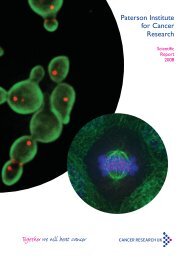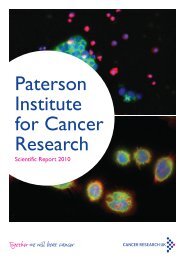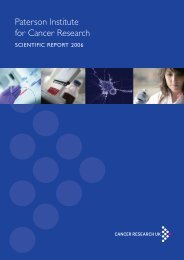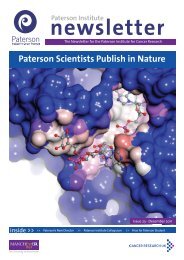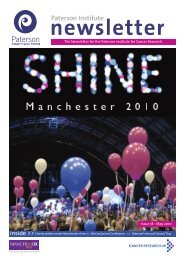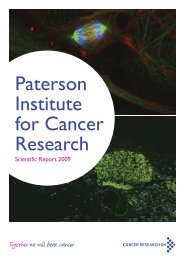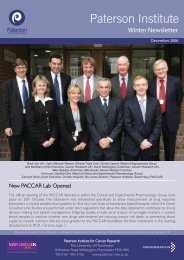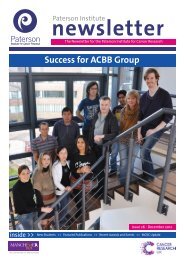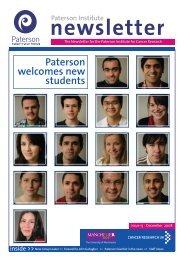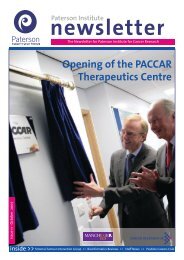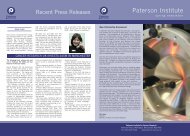Summer 2008 - The Paterson Institute for Cancer Research - The ...
Summer 2008 - The Paterson Institute for Cancer Research - The ...
Summer 2008 - The Paterson Institute for Cancer Research - The ...
You also want an ePaper? Increase the reach of your titles
YUMPU automatically turns print PDFs into web optimized ePapers that Google loves.
<strong>Paterson</strong> <strong>Institute</strong><br />
newsletter<br />
<strong>The</strong> Newsletter <strong>for</strong> the <strong>Paterson</strong> <strong>Institute</strong> <strong>for</strong> <strong>Cancer</strong> <strong>Research</strong><br />
<strong>Paterson</strong> invests £500,000 in<br />
new Mass Spec equipment<br />
Issue 14 - July <strong>2008</strong><br />
inside >> EMBO Fellowship >> New Group Leader >> Open Day >> Race <strong>for</strong> Life >> Staff Benefits
2<br />
<strong>Paterson</strong> Newsletter - <strong>Summer</strong> <strong>2008</strong><br />
Director’s Introduction<br />
We have recently concluded our discussions with CR-UK on the proposed budget <strong>for</strong><br />
<strong>2008</strong>/2009. This is an important process since the CR-UK core budget provides<br />
approximately 80% of our overall budget. During the process we assess our success<br />
over the last annual funding period compared to our stated objectives and agree<br />
our objectives <strong>for</strong> the coming period. It’s a very constructive and robust exercise<br />
and the final settlement was extremely satisfactory, especially given the very<br />
challenging fundraising climate that major charities like CR-UK face. <strong>The</strong><br />
uncertain economic situation presents significantly greater challenges than<br />
normal.<br />
An annual staff meeting is held to widely communicate the results and discuss our future<br />
plans. This meeting took place in early June and below is a brief summary of the most salient<br />
points.<br />
<strong>The</strong> most important research objectives <strong>for</strong> 2007/<strong>2008</strong> were to increase our contingent of<br />
Group Leaders and to invest further in our research services to ensure that they remain at<br />
the cutting edge. <strong>The</strong>re was significant achievement in both areas. 3 new group leaders were<br />
recruited enhancing our expertise and activity in stem cell biology, cell signalling and the<br />
tumour microenvironment. <strong>Research</strong> services were enhanced by further recruitment and<br />
purchase of state-of-the-art equipment. For example, a new Head of the FACS Service was<br />
recruited and the facility improved by a complete refurbishment and by purchase of a new<br />
analyser. Similarly, the capacity of the mass spec service was significantly enhanced by the<br />
purchase of a new Orbitrap machine. However, all the services were improved – they are<br />
very important to the success of the <strong>Institute</strong> and keeping at the cutting edge is essential.<br />
Our Estates department were busy overseeing the refurbishment and upgrade of quite a<br />
few of the research support areas plus a new conference room and new offices.<br />
<strong>The</strong> Operational Services achieved all of their objectives and the Careers Club <strong>for</strong> postdocs<br />
and students has gone from strength to strength, which is culminating in a one day course<br />
entitled ‘Introduction to <strong>Research</strong> Management’.<br />
<strong>Paterson</strong> <strong>Institute</strong> <strong>for</strong><br />
<strong>Cancer</strong> <strong>Research</strong><br />
<strong>The</strong> University of Manchester<br />
Wilmslow Road<br />
Manchester<br />
M20 4BX<br />
t: 0161 446 3156<br />
<strong>The</strong> objectives <strong>for</strong> <strong>2008</strong> / 2009 include the recruitment of 2 new group leaders and the Head<br />
of Drug Discovery, the development of a drug discovery programme and the enhancement<br />
of the quality of the <strong>Institute</strong>’s research portfolio which will be demonstrated by successful<br />
site visits of CEP in November <strong>2008</strong> and of the <strong>Institute</strong> in July 2009. As you will see on the<br />
facing page, the first group leader appointment has been made.<br />
As you can see we face a challenging year but I am confident that with everyone’s help, we<br />
will achieve our goals!<br />
Nic Jones<br />
Director<br />
www.paterson.man.ac.uk<br />
<strong>The</strong> University of Manchester<br />
Royal Charter Number: RC000797<br />
Credits: Cover photograph and those on pages 4 and 9 were supplied by Steve Royle
<strong>Paterson</strong> Newsletter - <strong>Summer</strong> <strong>2008</strong> 3<br />
<strong>Paterson</strong> Postdoc wins prestigious<br />
EMBO fellowship<br />
by Iain Hagan<br />
Marisa Madrid arrived in the <strong>Institute</strong> in January from the<br />
University of Murcia, having completed a very productive<br />
analysis of the stress responsive signalling MAP kinase cascades<br />
in fission yeast in her graduate studies.<br />
Marisa had been studying a MAP kinase signalling pathway that<br />
is known as the Cell Integrity Pathway (CIP). Marisa discovered<br />
that this pathway responded to a much wider range of stresses<br />
than had been previously appreciated, be<strong>for</strong>e establishing that<br />
CIP signalling was intimately entwined with that of a second<br />
MAP kinase signalling pathway that is known as the stress<br />
response pathway (SRP). It is the SRP that the Cell Regulation<br />
and Cell Division groups have been studying <strong>for</strong> many years<br />
because all major stresses impact upon signalling through this<br />
pathway in some way to alter transcriptional control through a<br />
transcription factor called atf1. Marisa established that SRP<br />
signalling activated several protein phosphatases to turn off CIP<br />
signalling. <strong>The</strong>se are important observations <strong>for</strong> the field as<br />
these two pathways can no longer be considered to be<br />
autonomous signalling modules.<br />
Marisa was keen to expand upon this solid foundation in fission<br />
yeast cell biology/genetics by joining the Cell Division group here<br />
in the <strong>Paterson</strong> <strong>Institute</strong> to understand how the environmental<br />
signalling pathways, that she studied so extensively in her<br />
graduate programme, regulate the time at which cells divide.<br />
This is a key area to understand because it is vital that cells do<br />
not divide when they have just been damaged by environmental<br />
insult. If they were to do so then any damage to the genome<br />
that has been inflicted by the insult would be fixed and<br />
propagated to all subsequent generations. Understanding this<br />
link will identify how the physiology of cancer cells differs from<br />
those in the surrounding tissue because cancer cells are growing<br />
in the wrong place and are invariably highly stressed. Such<br />
distinctions between trans<strong>for</strong>med and non-trans<strong>for</strong>med tissues<br />
offer novel avenues <strong>for</strong> therapeutic intervention.<br />
In order to support her time in the <strong>Paterson</strong> <strong>Institute</strong> Marisa<br />
applied <strong>for</strong> a prestigious EMBO fellowship. After making it<br />
through a tough selection round Marisa was interviewed in<br />
Helsinki and recently heard that her application was successful.<br />
Success in obtaining such internationally competitive<br />
independent fellowship support is a major achievement that will<br />
stand Marisa in great stead in fulfilling her ambition <strong>for</strong> an<br />
independent career. It also reflects well on the <strong>Institute</strong> in<br />
bringing the recognition of the <strong>Paterson</strong> and its facilities as a<br />
centre <strong>for</strong> world class science. We there<strong>for</strong>e wish Marisa all the<br />
best in her studies here and hope that future applications to<br />
independently support work in the <strong>Institute</strong> will be as successful.<br />
New Group Leader Appointed<br />
Dr Ivan Ahel from the CR-UK London Reseach <strong>Institute</strong>, where he is currently a postdoctoral fellow in the laboratory of Steve West,<br />
has accepted a Group Leader position in the <strong>Paterson</strong> <strong>Institute</strong>.<br />
This laboratory is one of the very top laboratories in the world working on DNA replication and repair. Ivan recieved his PhD from<br />
the University of Zagreb, Croatia, having carried out much of his thesis work in the laboratory of Dieter Soll at Yale University. His<br />
future research will focus on DNA repair functions regulated by poly(ADP-ribosyl)ation and particularly on proteins that have a<br />
novel binding motif that recognises poly(ADP-ribose). We are delighted that Ivan will be joining us.
4<br />
<strong>Paterson</strong> Newsletter - Spring <strong>2008</strong><br />
<strong>Paterson</strong> invests £500,000 in new<br />
Mass Spec equipment<br />
by Duncan Smith<br />
<strong>The</strong> history of the MBCF Mass Spec service is short and very<br />
eventful. <strong>The</strong> service was born in April 2004, when the <strong>Institute</strong><br />
purchased of two mass spectrometers jointly with Tony<br />
Whetton’s academic group. Shortly after, an LC-MSMS protein<br />
identification service was opened to all scientists on the<br />
<strong>Paterson</strong> site.<br />
Since then, the service portfolio has grown rapidly to provide<br />
numerous applications including phosphorylation mapping,<br />
quantitative phosphorylation analysis, iTRAQ quantitation, SILAC<br />
quantitation and directed proteome mining (to name a few).<br />
This massive expansion in applications has been driven from<br />
extremely fruitful collaborations with groups from the <strong>Institute</strong><br />
designed to implement workflows that push the boundaries of<br />
LCMS technology to cancer research. This model of <strong>Paterson</strong><br />
driven applications development directly feeding world-class<br />
service provision is a key strength that differentiates our facility<br />
from the crowd.<br />
<strong>The</strong> MBCF MS service was extremely <strong>for</strong>tunate to secure £0.5<br />
million pounds of CR-UK funding <strong>for</strong> a new LCMS plat<strong>for</strong>m <strong>for</strong><br />
the 07-08 financial year. As part of this process, the Mass Spec<br />
lab has undergone a full refurbishment to provide an<br />
appropriate environment <strong>for</strong> these cutting-edge instruments. In<br />
March 08, we installed our new LCMSMS plat<strong>for</strong>m designed to<br />
provide an unrivalled protein identification service. This new<br />
plat<strong>for</strong>m consists of the nano Acquity Ultra High per<strong>for</strong>mance<br />
LC system and the LTQ-Orbitrap XL mass spectrometer. <strong>The</strong> new<br />
LC system facilitates maximum resolution peptide separations<br />
and the Orbitrap is the highest per<strong>for</strong>mance protein<br />
identification mass spectrometer in the world today. <strong>The</strong><br />
procurement has already delivered on its promise of maximum<br />
per<strong>for</strong>mance protein identification with an effective boost in<br />
sensitivity of 100 fold over the previous generation of<br />
instruments. In addition, this plat<strong>for</strong>m has more than doubled<br />
our service throughput capabilities. <strong>The</strong>re is now a requirement<br />
to build an in<strong>for</strong>matic pipeline capable of utilising both the<br />
volume and quality of the data being produced. Our priority is<br />
now to provide such an in<strong>for</strong>matic solution to efficiently<br />
translate these data into research enhancing in<strong>for</strong>mation rapidly.<br />
<strong>The</strong> Nano Acquity-Orbitrap plat<strong>for</strong>m represents our major tool<br />
in terms of our protein identification, quantitation and posttranslational<br />
interests into the future.<br />
<strong>The</strong>re is going to be an explosion of applications on this plat<strong>for</strong>m<br />
in the coming year (including workflows currently serviced on<br />
the older instruments and totally new applications). <strong>The</strong><br />
applications developed will be driven directly from the needs of<br />
the research groups on site (so get in there quick).<br />
I’m now proud to offer a Mass Spec service with truly world-class<br />
capabilities.<br />
Here’s to a very bright <strong>2008</strong> and beyond. Thanks to all involved<br />
<strong>for</strong> support and patience.
<strong>Paterson</strong> Newsletter - <strong>Summer</strong> <strong>2008</strong> 5<br />
Genomic Analysis of Archival<br />
Material meeting June 08<br />
by Stuart Pepper<br />
In June the <strong>Paterson</strong> <strong>Institute</strong> played host to a one day<br />
meeting examining progress in the genomic analysis of<br />
archival <strong>for</strong>malin fixed paraffin embedded samples. <strong>The</strong>se<br />
samples represent an invaluable resource as there are<br />
literally millions of such samples stored in hospitals around<br />
the UK, often with several years clinical follow up.<br />
Traditionally it has not been possible to extract DNA and<br />
RNA from these samples however in the last few years there<br />
have been improvements in methods which are now<br />
allowing exploitation of this resource.<br />
To open the day Professor Gordon Stamp, from the Imperial<br />
College Faculty of Medicine, discussed different ways in<br />
which samples can be treated during the fixation process<br />
Host Stuart Pepper introduces Dr Kim Linton to discuss her recent work<br />
and how this can impact on the quality of subsequent<br />
with archival samples.<br />
analysis. Further talks from Dr Phil Chambers (Genomic<br />
Variation Laboratory Service, CR-UK) and Dr Angela Jones (London <strong>Research</strong> <strong>Institute</strong>), who discussed how archival DNA could be<br />
analysed using either pyrosequencing and microarray plat<strong>for</strong>ms, completed the morning session.<br />
During the day Dr Kim Linton, from the Christie Hospital, presented the results of a project that has been carried out in collaboration<br />
between the <strong>Paterson</strong> <strong>Institute</strong>, the Christie Hospital and <strong>The</strong> University of Manchester. This work has resulted in a recent publication<br />
in the British Journal of <strong>Cancer</strong> describing the acquisition of clinically relevant microarray data from archival sarcoma samples. Since<br />
writing the paper there have been further technical<br />
developments and Kim was able to present these to a<br />
mixed audience of academic scientists, clinicians and<br />
NHS staff, all of whom had an interest in this technology.<br />
Kim concluded by remarking that this had been a good<br />
example of the MCRC in action as it had required<br />
coordination of a highly multidisciplinary team to<br />
achieve the final publication.<br />
Presentations were also given by Mahesh Iddewela<br />
(University of Cambridge) on an alternate approach to<br />
microarray profiling of archival material and Dr Gavin<br />
Kelly, who rounded the day off with an excellent<br />
presentation discussing the difficulties of working with<br />
data generated from these particularly challenging<br />
samples.<br />
Professor Gordon Stamp from the Imperial College Faculty of Medicine opened the day
6<br />
<strong>Paterson</strong> Newsletter - <strong>Summer</strong> <strong>2008</strong><br />
<strong>Paterson</strong> at Race <strong>for</strong> Life<br />
by James Dunphy<br />
On Sunday 1st June a team of a dozen representatives from the<br />
<strong>Paterson</strong> <strong>Institute</strong> lent their support to Manchester’s Race <strong>for</strong> Life.<br />
This race had 6,700 women from across Manchester running the<br />
5km course to raise money <strong>for</strong> <strong>Cancer</strong> <strong>Research</strong> UK.<br />
<strong>The</strong> day is best described by one of the participants:<br />
Monique Melis (Targeted <strong>The</strong>rapy)<br />
and Najma Rachidi (Cell Division)<br />
hand out medals<br />
“We arrived at 10am (5 in our group, ages ranging from 9-40 years<br />
old) the rain was falling and by the time we started the race we<br />
were soaked to the skin. What a brilliant atmosphere, what a<br />
feeling when you finish, I know it's about raising money but if<br />
you were there you'd of seen it was more than that. Every person<br />
there gave a few hours of their time in the rain, soaked to the skin,<br />
crossed over the finishing line with a smile. Thank You to<br />
everyone.”<br />
Thanks to Claire, Najma, Olga, Seema, Mandy, Ting, Ahmet,<br />
Dimitrios, Gail, Aileen, Babra and Monique who helped lead the<br />
runners to the start, cheer them up the last hill, keep the crowds<br />
back(!) and provide the well deserved medals at the end. It is<br />
hoped that this race will raise over £500,000 <strong>for</strong> the Charity.<br />
<strong>Paterson</strong> staff on duty at the finish line<br />
<strong>Paterson</strong> staff and volunteeers be<strong>for</strong>e the race<br />
<strong>Paterson</strong> staff and volunteeers lead the runners<br />
to the starting line
<strong>Paterson</strong> Newsletter - <strong>Summer</strong> <strong>2008</strong> 7<br />
Keswick to Barrow walk<br />
By Sarah Lewis<br />
All my hiking friends told me I was<br />
completely mad. ‘You’re going to walk<br />
through the Lake District,’ they said, ‘<strong>for</strong><br />
40 miles, by-passing all those lovely hills?’<br />
Admittedly, a 40 mile race along a flat<br />
tarmac road is not my typical hiking day<br />
out, but since it’s in aid of a good cause I<br />
decided to at least give it a try.<br />
I slightly regretted my decision when we<br />
were rudely awakened in the middle of<br />
the night to hastily get ready and<br />
sleepwalk our way down the road to the<br />
coach that was taking us from Barrow to<br />
the race start. I do remember Katalin and<br />
Martin (this year’s brilliant walk<br />
organisers) telling everyone that it was an<br />
early start….but 3.30 am?! We began to<br />
realise exactly what we had taken on<br />
when the coach took a painfully long time<br />
to reach our destination, acutely aware as<br />
we were that however far the bus drove<br />
us, we had to walk that same distance<br />
back again. Without any time <strong>for</strong> second<br />
thoughts we were off, swiping our time<br />
tags at the start line. Many members of<br />
the 21-strong <strong>Paterson</strong> team sped off into<br />
the distance, but my aim was simply to<br />
finish the walk, never mind doing it<br />
quickly, so I set off at and maintained my<br />
usual hiking pace: a slow plod. <strong>The</strong><br />
weather was unusually nice <strong>for</strong> the Lake<br />
District, sunny but with enough cloud<br />
cover to keep the temperature cool. Even<br />
without hilltop views, I have to admit that<br />
the scenery throughout the first half of<br />
the walk was stunning. I greatly<br />
appreciated the rare opportunity to look<br />
out over the waters of Thirlmere bathed<br />
in a beautiful dawn light. Carrying<br />
enough rations <strong>for</strong> a week was perhaps<br />
not entirely necessary as the K2B is<br />
incredibly well organised, with regular<br />
checkpoints offering food, drink and first<br />
aid, and a feast of sandwiches at 20 miles.<br />
I think that everyone was, however, a little<br />
sick of orange squash and bananas by the<br />
end of the day.<br />
After a mere thirteen and a half hours I<br />
crossed the finish line, cheered on by a<br />
small yet dedicated welcoming<br />
committee. I was reunited with my much<br />
speedier team-mates, nursing their<br />
blisters back at the B&B, and we treated<br />
ourselves to a well-deserved takeaway<br />
dinner. This year the sponsorship raised is<br />
being split equally between Christie’s<br />
Hospital and <strong>Cancer</strong> <strong>Research</strong> UK, so<br />
many thanks to friends, relatives and of<br />
course staff and students here at the<br />
<strong>Paterson</strong> <strong>Institute</strong> <strong>for</strong> your generosity, it is<br />
much appreciated.<br />
Acknowledgements, facts and stats:<br />
This year’s total sponsorship raised is over<br />
£2,500! Thank you to all our colleagues,<br />
friends and family <strong>for</strong> the very generous<br />
contributions!<br />
Special thanks to Denise Owen <strong>for</strong> her<br />
help with the fundraising, and to our<br />
corporate sponsors: Scientific Lab Supplies,<br />
Jencons, Bioline, <strong>The</strong> Danwood Group,<br />
Starlab.<br />
<strong>The</strong> team members would also like to give<br />
a big thank you to James Dunphy, Chris<br />
Wareing, Sandra Strassburg and Deepthy<br />
Francis <strong>for</strong> their encouragement and<br />
patience at the 30-mile mark and their<br />
support be<strong>for</strong>e and after the walk.<br />
<strong>The</strong> two <strong>Paterson</strong> teams were ranked 52<br />
and 101 from 244 teams and 19 and 38<br />
from 54 teams outside of Cumbria. Our<br />
fastest team member was Chris<br />
Cawthorne, who finished 38 out of 2,029<br />
starters (1,822 walkers finished)<br />
<strong>The</strong> individual times this year were<br />
(h.min.sec.):<br />
Chris Cawthorne: 6.32.13<br />
John Mcburney: 7.16.04<br />
Gavin Wilson: 7.57.58<br />
Katalin Boros: 8.37.07<br />
Patrycja Sroczynska: 9.13.11<br />
Arek Welman: 9.14.16<br />
Nimesh Joseph: 9.18.55<br />
Lu Zhang: 9.48.03<br />
Jian Mei Hou: 9.49.12<br />
Cristina Martin-Fernandez: 9.52.50<br />
Martin Brandenburg: 9.53.00<br />
Deborah Maskell: 12.22.40<br />
Guilherme Costa: 12.24.24<br />
Peter Molitorisz: 12.24.35<br />
Wilawan Bunjobpol: 12.26.54<br />
Ting Zheng: 12.47.40<br />
Sarah Lewis: 13.28.07<br />
Catriona Parker: 14.25.43<br />
Lenka Zvirinska: 30 miles completed<br />
Silvia Oliveira: 35 miles completed<br />
Olga Tsoulaki: 20.5 miles completed
8<br />
<strong>Paterson</strong> Newsletter - <strong>Summer</strong> <strong>2008</strong><br />
In Brief<br />
Congratulations to Jeff Cummings, Tim Ward, Alastair Greystoke, Malcolm Ranson and Caroline Dive whose paper -<br />
biomarker Method Validation in Anticancer Drug Development - was downloaded a total of 767 times in February from<br />
the British Journal of Pharmacology, making it one of the top 3 downloaded papers in February <strong>2008</strong>.<br />
Staff News<br />
Congratulations to Ricky van Deursen (Cell Cycle) and his wife Hilary on the birth of<br />
their son Matthew James van Deursen (right) Born 23rd May <strong>2008</strong> at 1.38am<br />
Weighing 6lb 2oz.<br />
Welcome to.......<br />
Vincent Pritchard - Domestic<br />
Helen Rushton - Cell Signalling group - Postdoc<br />
Luke Harrison - CEP - Postdoc<br />
Kieran Mellody - Stromal Tumour Interaction - Senior Scientific Officer<br />
Yasushi Kojima - Akira's Lab - Postdoc<br />
Gary Spencer - Leukaemia Biology Lab - Senor Scientific Officer<br />
Owen McGinn - Immunology group - Postdoc<br />
Matthew Lancashire - CEP - Laboratory Aide<br />
Carol Walley - Domestic<br />
TRF Refurbishment<br />
by Jenny Varley<br />
By the time you all read this the building works on the second floor will be completed. Given the experience with the previous scheme<br />
this development has been a delight to oversee. As well as the obvious lack of frequent fire alarms (usually during heavy rain so that<br />
we all get cold and wet!), there has been minimal disruption to any activities in the <strong>Institute</strong>. <strong>The</strong> main contractors, Parkinsons, have<br />
been excellent and a pleasure to work with. <strong>The</strong> scheme has slightly over-run but only by a week or so, and by the middle of June we<br />
should have <strong>for</strong>mally accepted the area.<br />
<strong>The</strong> development provides refurbished accommodation <strong>for</strong> Peter Stern’s Immunology group as shown in the picture below, and new<br />
space <strong>for</strong> a facility <strong>for</strong> assays done to the<br />
standard of GCLP associated with<br />
immunotherapy trials. <strong>The</strong>re is also space <strong>for</strong><br />
a Chair in Breast Oncology plus up to two<br />
further group leaders (all to be appointed).<br />
<strong>The</strong> laboratories and offices have been<br />
designed such that the areas should be<br />
suitable <strong>for</strong> most activities, including tissue<br />
culture space and instrument rooms. <strong>The</strong>re is<br />
also a large shared facility <strong>for</strong> minus 80 0<br />
freezers and nitrogen storage, instrument<br />
rooms and a good-sized working cold room.<br />
<strong>The</strong> same contractors recently finished work<br />
on the ground floor, with a new conference<br />
room and improved facilities <strong>for</strong> Mass<br />
Spectrometry, Flow Cytometry, Finance and<br />
the MCRC office.
<strong>Paterson</strong> Newsletter - <strong>Summer</strong> <strong>2008</strong> 9<br />
Group Spotlight - <strong>The</strong> Stromal<br />
Tumour Interaction Group<br />
by Akira Orimo<br />
Tumours are highly complex tissues and<br />
the non-neoplastic cell compartment of<br />
tumours, which is often termed the<br />
“stroma”, is itself quite complex<br />
histologically.<br />
Carcinoma cells initially recruit and/or<br />
activate these various stromal nonneoplastic<br />
cells, including fibroblasts,<br />
myofibroblasts, immune cells, endothelial<br />
cells, bone marrow-derived cells etc. <strong>The</strong><br />
resulting stromal cells reciprocate by<br />
fostering carcinoma cell growth and<br />
survival during the course of tumour<br />
progression.<br />
Left to right - Keiran Mellody,<br />
Yasushi Kojima, Akira Orimo,<br />
Ahmet Acar<br />
Studying the heterotypic interactions<br />
between the neoplastic cells and the<br />
supporting stroma is believed to be essential <strong>for</strong> understanding nature of a bulk of carcinoma mass.<br />
However, such research fails to include and address another variable: that the stroma is itself<br />
altered and might co-evolve with the tumour cells during the course of tumour progression.<br />
Indeed, numbers of these myofibroblasts are very often recruited into invasive human breast<br />
carcinomas and involved in tumour progression.<br />
Myofibroblasts are also observed in areas of wound healing, fibrosis, and chronic inflammation.<br />
<strong>The</strong>se cells produce abundant levels of extracellular matrix (ECM), cytokines and growth factors<br />
that aid in tissue repair and promote angiogenesis in sites of damaged tissues.<br />
We previously demonstrated that a large population of myofibroblasts, designated carcinomaassociated<br />
fibroblasts (CAFs), extracted from invasive human breast carcinomas exhibited an ability<br />
to promote carcinoma growth and angiogenesis. Thus, myofibroblast-secreted stromal cell-derived<br />
factor-1 (SDF-1)/CXCL12 chemokine mediated, in part, the tumour-promoting ability of these<br />
myofibroblasts by recruiting endothelial progenitor cells (EPCs) into tumour, boosting angiogenesis<br />
(Orimo et al, Cell, 121, 335-48, 2005; Orimo and Weinberg, Cell Cycle, 5, 1597-601, 2006).<br />
To further understand the biology of stromal myofibroblasts in tumour, we intend to study<br />
myofibroblast-tumour cell interaction in several aspects. Stroma-derived signaling likely provides<br />
a support <strong>for</strong> carcinoma cells to facilitate invasion and metastasis during tumour progression, an<br />
important biological process that remains poorly understood in spite of a decade of intensive study<br />
by many research groups. Studying about molecular insights by which these stromal cells coevolve<br />
with carcinoma cells will help understand nature of tumour-prone microenvironment.<br />
<strong>The</strong> ultimate aim would be to find out an attractive target <strong>for</strong> the development of anti-tumour<br />
therapies based on disturbing the stroma-tumour cell interactions.
10<br />
<strong>Paterson</strong> Newsletter - <strong>Summer</strong> <strong>2008</strong><br />
Reflection on my PhD<br />
by Claire Rooney<br />
I started at the <strong>Paterson</strong> <strong>Institute</strong> back in 2004. <strong>The</strong><br />
first year of my PhD consisted of three rotation<br />
projects, which was a great way to get to know the<br />
<strong>Institute</strong> and its staff.<br />
I started out in the Cell Regulation laboratory and,<br />
being fairly new to lab work at the time, I was very<br />
grateful to everyone there <strong>for</strong> patiently helping me to<br />
get started with the various techniques. After that I<br />
moved down the corridor to Cell Signalling and finally<br />
onto Stem Cell Haematopoiesis. I really enjoyed all<br />
three projects, but I chose to go back to Cell Signalling<br />
to complete my PhD project. I have been examining<br />
the role of the Tiam1 homologue, STEF, in various<br />
aspects of tumourigenesis in my time here, which has<br />
yielded some interesting results.<br />
Outside of the lab, I’ve been enjoying life in Manchester, it’s a great city and I’ve also been part<br />
of some fun houseshares, which always makes moving to a new place much easier. I’ve been<br />
playing hockey <strong>for</strong> Wilmslow <strong>for</strong> the last three years, which has been fantastic.<br />
Claire Rooney at work in the lab<br />
Four years really does fly by, I can’t believe that my time as a PhD student is coming to an end.<br />
I’ve learned a lot working in the Cell Signalling lab, due in no small part to the helpfulness of my<br />
labmates. I’ve made some great friends in my time here, and when the time comes to move on<br />
I’ll be sorry to say goodbye. For now, I’m trying to finish off a few things in the lab be<strong>for</strong>e getting<br />
on with the thesis writing – wish me luck!<br />
Science Communication Roadshow<br />
Twenty researchers at the were the first to take part in the<br />
Science Communication Roadshow, aimed at boosting their skills<br />
and confidence in communicating their work to the CR-UK<br />
supporters.<br />
In the words of Professor Nic Jones, who spoke at the start of the<br />
day, “our research is funded overwhelmingly by the generosity of<br />
the general public, and we have a duty to explain clearly what<br />
we do with their donations.”<br />
<strong>The</strong> Roadshow was set up to support LEAD (<strong>for</strong>merly Project<br />
Local), to empower scientists to interact with supporters in their<br />
local community. <strong>The</strong> topics covered included “Who are our<br />
supporters”, “Mind your language”, “Powerpoint pitfalls”, “Lab<br />
tours and open days” and “<strong>The</strong> media”.<br />
<strong>The</strong> Pilot workshop was a great success, with most attendees<br />
rating the day five out of five and saying it had increased their<br />
motivation to interact with our supporters. Comments included<br />
“a good mix of interactive activities and presentations” and<br />
“highly interactive without being embarrassing!”<br />
Depending on the final results of the <strong>for</strong>mal evaluation of the<br />
pilot, the Roadshow will be rolled out to the other CR-UK<br />
<strong>Institute</strong>s, and possibly other sites in future.
<strong>Paterson</strong> Newsletter - <strong>Summer</strong> <strong>2008</strong> 11<br />
<strong>Research</strong>ers of the future visit<br />
the <strong>Paterson</strong> <strong>Institute</strong><br />
by James Dunphy<br />
<strong>The</strong> <strong>Paterson</strong> <strong>Institute</strong> invited 48 of the best scientific sixth <strong>for</strong>m<br />
students from across the northwest to come and spend a day<br />
getting 'hands on' research experience.<br />
This is the 4th year that the event has taken place and it is<br />
growing in popularity with all the available places being taken up<br />
by the 8 schools involved. <strong>The</strong> event was originally developed by<br />
Dr Lez Fairbairn but has recently been run by Stuart Pepper, who<br />
is the Head of Molecular Biology Core Facility, and he stated:<br />
“<strong>The</strong> main aims are to inspire them into following research<br />
careers and help raise awareness of the research <strong>Cancer</strong> <strong>Research</strong><br />
UK funds.”<br />
beyond the students current learning. During the day the<br />
students had the opportunity to visit 3 areas of work <strong>for</strong> 90<br />
minute sessions. <strong>The</strong> <strong>Institute</strong> had representatives from 6 groups<br />
(Bioin<strong>for</strong>matics, Advanced Imaging, Cell Division, Immunology,<br />
Clinical Experimental Pharmacology, Molecular Biology Core<br />
Facility) to help facilitate the activities. <strong>The</strong> students were given<br />
the opportunity to run PCR’s, read DNA sequences, per<strong>for</strong>m cell<br />
culture and use advanced imaging systems.<br />
<strong>The</strong>ir feedback from the event was excellent, with all stating that<br />
they enjoyed the activities and found them relevant with many<br />
stating they would like to learn even more. One student said:<br />
<strong>The</strong> programme has been developed in line with the A-Level<br />
syllabus but also expanded to highlight the work that happens<br />
“It was great to see some real life labs; we would never get to see<br />
some of this amazing equipment back at school”<br />
Andrea Welsby, who is the Head of Biology teacher at Loretto<br />
Grammar School and who has been instrumental in helping to<br />
develop the day, stated:<br />
“I think it is fantastic <strong>for</strong> the students to have the opportunity to<br />
visit such an <strong>Institute</strong> and over the last four years I have seen some<br />
change their career aspirations and direction due to their<br />
experience here.”<br />
<strong>The</strong> day was a huge success both in terms of student experience<br />
and the support provided by the <strong>Paterson</strong> <strong>Institute</strong>, with all of<br />
the groups taking time to plan meticulous interactive, enjoyable<br />
sessions.
12<br />
<strong>Paterson</strong> Newsletter - <strong>Summer</strong> <strong>2008</strong><br />
<strong>The</strong> <strong>Institute</strong> opens its doors to<br />
fundraisers<br />
by James Dunphy<br />
On the 7th June the <strong>Institute</strong> hosted its biggest ever Open Day.<br />
We had more visitors and more demonstrations than ever be<strong>for</strong>e.<br />
<strong>The</strong> 90 visitors came from a variety of places, including<br />
volunteers from <strong>Cancer</strong> <strong>Research</strong> UK shops, members of cancer<br />
support groups, fundraising teams, even our local MP John Leech<br />
made an appearance.<br />
Caron Abbey and Garry Ashton give a demonstration in the<br />
Histology department<br />
<strong>The</strong> morning began with an update from the local fundraisers<br />
about <strong>for</strong>thcoming activities and recent successes. This was<br />
followed by a talk from Professor Hawkins about his current work<br />
in the CR-UK department of Medical Oncology.<br />
A quick lunch break and the visitors were split into 12 groups to<br />
begin the “best part of the day”. Each group was expertly guided<br />
around the <strong>Institute</strong>, where they had the opportunity to visit 4<br />
different labs <strong>for</strong> some excellent interactive demonstrations<br />
during their two hour tour.<br />
<strong>The</strong> feedback from the day was extremely positive, a treasurer<br />
from a fundraising group stated it was:<br />
“An excellent and in<strong>for</strong>mative day. I’m now spurred on to raise more<br />
money!”<br />
Geofff Margison demonstrates DNA ‘spooling’ to local<br />
funsraisers in the Carcinogenesis lab<br />
A volunteer from a <strong>Cancer</strong> <strong>Research</strong> UK shop was equally happy,<br />
saying:<br />
“Excellent day, it brings to life the wonderful research being done!”<br />
Thanks to all involved in this day as it was clearly a resounding<br />
success enjoyed by all.<br />
A cheque <strong>for</strong> over £10,000 was handed over to Mr Peter<br />
Whalley of CR-UK by the Moon and Stars group<br />
Local fundraisers gather in the coffee room prior to the start<br />
of the tours


